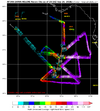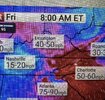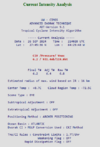As of late or maybe even historically, these gulf canes only get sharper as they near landfall. I wouldn’t bet against a late game buzzsaw lookQuite possibly the worst structured Cat 3 storm I have ever seen.
-
Hello, please take a minute to check out our awesome content, contributed by the wonderful members of our community. We hope you'll add your own thoughts and opinions by making a free account!
You are using an out of date browser. It may not display this or other websites correctly.
You should upgrade or use an alternative browser.
You should upgrade or use an alternative browser.
Tropical Major Hurricane Helene
- Thread starter SD
- Start date
- Status
- Not open for further replies.
Psalm 148:8
Member
- Joined
- Dec 25, 2016
- Messages
- 320
- Reaction score
- 703
So are we expecting landfall around 11 pm?
Drizzle Snizzle
Member
I'm just curious how strong the winds will be on the west side of the center as it tracks through the southern half of Georgia. I'm just not really sure what to expect honestly.
Drizzle Snizzle
Member
I saw something where the Hurricane force winds extend 60 miles from the center but not sure if thats only to the east of the center or not.
HugeSnowStick
Member
Hurricane Warning south Atlanta suburbs.
Snowflowxxl
Member
Drizzle Snizzle
Member
Are you sure ? I'm only seeing a Hurricane Warning as far north as Lamar and Monroe counties. I don't even see Griffin or McDonough in the Hurricane Warning.Hurricane Warning south Atlanta suburbs.
Are you sure ? I'm only seeing a Hurricane Warning as far north as Lamar and Monroe counties. I don't even see Griffin or McDonough in the Hurricane Warning.
HugeSnowStick
Member
Just saw it on WSB 2, Brad NitzAre you sure ? I'm only seeing a Hurricane Warning as far north as Lamar and Monroe counties. I don't even see Griffin or McDonough in the Hurricane Warning.
Last minute scare tactic to try and get people to leave. Still very dangerous to stay.
Sctvman
Member
- Joined
- Jan 23, 2021
- Messages
- 4,042
- Reaction score
- 12,736
- Location
- Lebanon Township, Durham County NC
-------- thinks she makes 140MPH
HugeSnowStick
Member
I guess you do not realize how big Metro Atlanta is...Google it.Ok so I guess if you consider Griffin the southern suburbs then HugeSnowStick is right.
BHS1975
Member
Tons of lightning in the eye wall.
Sent from my iPhone using Tapatalk
Sent from my iPhone using Tapatalk
- Joined
- Jan 23, 2021
- Messages
- 4,042
- Reaction score
- 12,736
- Location
- Lebanon Township, Durham County NC
Tornado warning for wake
EastmanGAWX
Member
I've already recorded well over five inches of rain, I actually think that the number of trees down in Middle/South Georgia tonight will be astronomical in terms of coverage due to the combination of wind speed/moisture soaked ground. I told someone earlier that I think that this will have the potential to do more damage (maybe not as intense) over a bigger geographic area than Michael.
Drizzle Snizzle
Member
You are in a really bad location.I've already recorded well over five inches of rain, I actually think that the number of trees down in Middle/South Georgia tonight will be astronomical in terms of coverage due to the combination of wind speed/moisture soaked ground. I told someone earlier that I think that this will have the potential to do more damage (maybe not as intense) over a bigger geographic area than Michael.
We haven't even had the main show yet.Tornado warning for wake
CI# /Pressure/ Vmax
6.2 / 931.5mb/119.8kt
Latest Dvorak estimate.
6.2 / 931.5mb/119.8kt
Latest Dvorak estimate.
Downeastnc
Member
Going to be a really different experience depending on what side of the center you are on, west side still not showing much of anything with surface winds barely over 50-60 mph even right on the center....versus the east side where surface winds at cane force 150 miles from the center.....there is still 4-5 hrs for her to get that sorted out some but it seems unlikely outside of a tight core of winds around the western eyewall is she can get it built in time.


Interesting dynamic, IR is probably the best it has looked but the eyewall on radar has degraded tremendously on the western side over the past hour. That said that isn’t unexpected in hurricanes under these circumstances.
That said that eastern wall is a beast.
That said that eastern wall is a beast.
coldspringsfarm
Member
Most of the mesoscale models continue to show a track to the north east corner of Georgia? Are they not trustworthy for tropical systems? The nhc track is much different.
Stadium effect on visible now as the sun goes down.
Wherever that eastern eyewall comes ashore will likely see a 20ft plus storm surge. Hopefully it’s in as little a populated area as possibleInteresting dynamic, IR is probably the best it has looked but the eyewall on radar has degraded tremendously on the western side over the past hour. That said that isn’t unexpected in hurricanes under these circumstances.
That said that eastern wall is a beast.
944 mb.
215130 2754N 08427W 7519 02052 9466 +224 +146 213021 023 /// /// 03
215130 2754N 08427W 7519 02052 9466 +224 +146 213021 023 /// /// 03
- Joined
- Jan 23, 2021
- Messages
- 4,042
- Reaction score
- 12,736
- Location
- Lebanon Township, Durham County NC
Just saw that 944MB reading. It’s under 3k by 9MB at this time frame.
215230 2754N 08422W 7527 02045 9467 +227 +145 204039 042 /// /// 03
215300 2754N 08419W 7519 02057 9462 +239 +130 205044 045 /// /// 03
215330 2754N 08417W 7517 02061 9466 +237 +139 204050 053 /// /// 03
215400 2753N 08414W 7523 02063 9478 +227 +157 201063 071 /// /// 03
215430 2753N 08412W 7522 02078 9510 +199 +171 199077 082 /// /// 03
215500 2753N 08409W 7521 02097 9537 +186 +185 198088 089 /// /// 05
215530 2753N 08407W 7512 02125 9556 +184 +180 200099 107 /// /// 03
215600 2753N 08404W 7512 02138 9582 +173 +187 198124 128 /// /// 05
215630 2753N 08402W 7529 02135 9603 +171 +182 195130 134 /// /// 05
215700 2753N 08400W 7497 02186 9627 +161 +188 188134 136 /// /// 05
215730 2753N 08358W 7523 02178 9648 +159 +183 186134 136 /// /// 05
215800 2753N 08356W 7522 02206 9676 +163 +182 185126 130 /// /// 05
215830 2753N 08354W 7524 02225 9705 +156 +175 184118 124 /// /// 05
215900 2753N 08351W 7513 02254 9717 +162 +175 184116 117 /// /// 05
215930 2753N 08349W 7523 02258 9726 +169 +177 185110 115 /// /// 05
220000 2753N 08347W 7516 02273 9741 +164 +177 187108 108 /// /// 05
220030 2753N 08345W 7518 02286 9754 +164 +174 184104 108 /// /// 05
220100 2753N 08343W 7516 02295 9763 +165 +168 183099 102 /// /// 05
220130 2753N 08341W 7519 02299 9775 +162 +168 184096 097 /// /// 05
220200 2753N 08339W 7520 02305 9779 +165 +174 184095 096 /// /// 05
136 kt flight-level winds. The SFMR sensor is not working.
215300 2754N 08419W 7519 02057 9462 +239 +130 205044 045 /// /// 03
215330 2754N 08417W 7517 02061 9466 +237 +139 204050 053 /// /// 03
215400 2753N 08414W 7523 02063 9478 +227 +157 201063 071 /// /// 03
215430 2753N 08412W 7522 02078 9510 +199 +171 199077 082 /// /// 03
215500 2753N 08409W 7521 02097 9537 +186 +185 198088 089 /// /// 05
215530 2753N 08407W 7512 02125 9556 +184 +180 200099 107 /// /// 03
215600 2753N 08404W 7512 02138 9582 +173 +187 198124 128 /// /// 05
215630 2753N 08402W 7529 02135 9603 +171 +182 195130 134 /// /// 05
215700 2753N 08400W 7497 02186 9627 +161 +188 188134 136 /// /// 05
215730 2753N 08358W 7523 02178 9648 +159 +183 186134 136 /// /// 05
215800 2753N 08356W 7522 02206 9676 +163 +182 185126 130 /// /// 05
215830 2753N 08354W 7524 02225 9705 +156 +175 184118 124 /// /// 05
215900 2753N 08351W 7513 02254 9717 +162 +175 184116 117 /// /// 05
215930 2753N 08349W 7523 02258 9726 +169 +177 185110 115 /// /// 05
220000 2753N 08347W 7516 02273 9741 +164 +177 187108 108 /// /// 05
220030 2753N 08345W 7518 02286 9754 +164 +174 184104 108 /// /// 05
220100 2753N 08343W 7516 02295 9763 +165 +168 183099 102 /// /// 05
220130 2753N 08341W 7519 02299 9775 +162 +168 184096 097 /// /// 05
220200 2753N 08339W 7520 02305 9779 +165 +174 184095 096 /// /// 05
136 kt flight-level winds. The SFMR sensor is not working.
NEGaweather
Member
Sent from my iPhone using Tapatalk
- Joined
- Jan 23, 2021
- Messages
- 4,042
- Reaction score
- 12,736
- Location
- Lebanon Township, Durham County NC
She’s already at 944 so I can see another 10mb at this rate which puts it close to some of the stronger prognostications
Drizzle Snizzle
Member
That radar change was incredible over the past twenty minutes.
I’ve watched them tighten, but never like that.
I’ve watched them tighten, but never like that.
Mahomeless
Member
Just thinking the same think looking at KTLHThat radar change was incredible over the past twenty minutes.
I’ve watched them tighten, but never like that.
- Status
- Not open for further replies.


